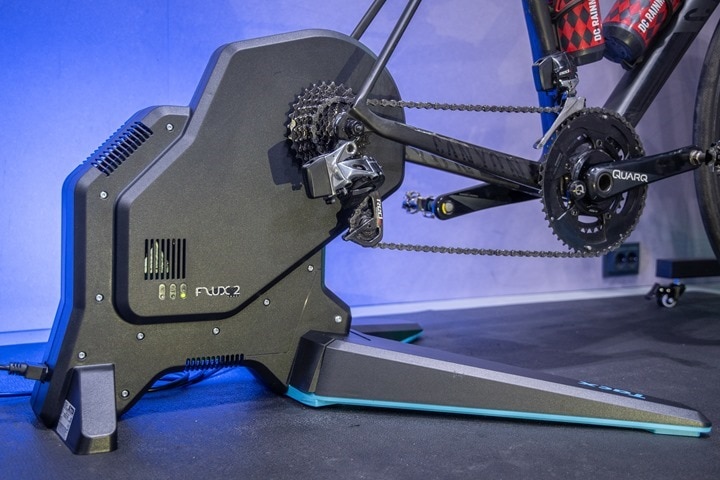
Wait, didn’t this trainer come out two years ago? And the answer to that is…sorta, but not exactly.
See, while the Flux 2 was announced in July 2018, it didn’t actually start shipping till late December 2018, and wasn’t really available until early 2019. It was around then that I got a unit, and it didn’t take long to determine it had legit road blocker issues, primarily with ERG mode and power accuracy horrifically off. So much so that I even put a warning up on my previous Flux 2 announcement posts saying straight up ‘Do not buy’.
Well, many moon phases later last summer in Aug 2019, Tacx semi-quietly revamped the internals to a new version (oft called the Tacx Flux 2.1). This gave it more internal resistance power to handle all sorts of scenarios, but also set the stage for fixing the earlier accuracy issues I found. Except, those weren’t fixed yet. That firmware update didn’t finally release until April 2020. Toss in another month in peak-COVID here in the Netherlands after UPS managed to destroy one, and we find ourselves here in July 2020 with a large number of rides under my belt.
Don’t worry, if you’ve got a Flux 2 of any sort, I’ll explain how exactly to identify which one you have. More on that later.
For now, with that is already a way-too-long introduction out of the way, let’s get right into it.
The Flux S vs Flux 1 vs Flux 2.0:
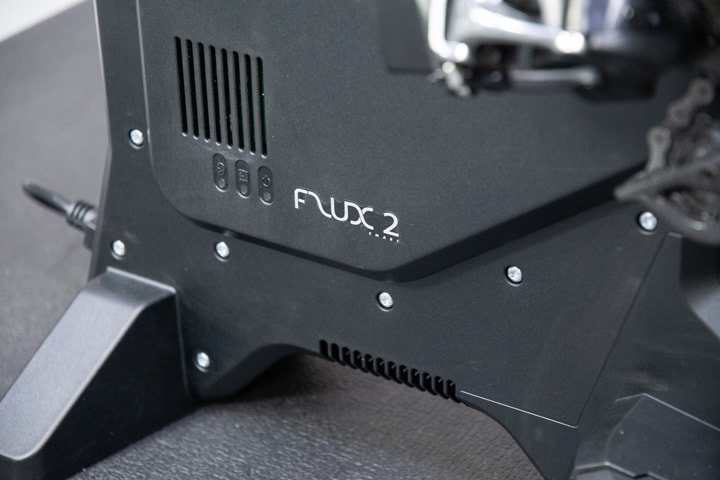
Now, if you turn on the way-back machine, the original Flux was actually the first so-called “mid-range” direct drive trainer. After Wahoo came out with the KICKR and then Tacx came out with the NEO, Tacx popped out the Flux in 2016 at $ 899. At the time that was a massive deal, and it dominated the market that year. It ultimately led to Elite making the Direto the following year (substantially increasing performance, as well as a minor bump in accuracy), and then also led to Wahoo offering the KICKR CORE (which in turn mostly killed the original Flux’s appeal).
Anyway, in summer 2018 Tacx announced the Flux 2, they also announced the Flux S. The Flux S basically just an original Flux at a lower price point (with a minor tweak to the case to allow for longer derailleur cages), but it enabled Tacx to undercut Wahoo and Elite on pricing. Meanwhile, the Flux 2 was designed to compete more on-spec with the Wahoo KICKR CORE.
So, to summarize up till this point:
Flux 1: First generation Flux with 10% grade simulation
Flux S: Basically a Flux 1, but with long derailleur cage support and some internal manufacturing tweaks
Flux 2: Far more powerful Flux with 16% grade simulation, increased accuracy claim
The main difference aside from the obvious 16% grade simulation was actually more substantial, specifically they increased the working area at low-speed but steep climbing. So with the original Flux 1, you’d top out at 225w if doing 15KPH. Whereas now on the Flux 2 you could do nearly 500w at 15KPH. That matters when going slow up climbs.

![clip_image002[6] clip_image002[6]](http://media.dcrainmaker.com/images/2020/07/clip_image0026_thumb.gif)
Ok, with me thus far? Good.
Fast forward 6 months later till December 2018 and Tacx finally started shipping the Flux 2. Add a few more months and as part of my review cycle I ran into accuracy issues in ERG mode that made it inaccurate at upwards of 10% off. Tacx was able to confirm these issues and set to work on them. Essentially, they had all this massive new braking/resistance power compared to a previous Flux, but it was no longer as accurate as the previous version.
So, Tacx quietly made more tweaks, working on what would debut in Summer/Fall 2019 as the Flux 2.1 (even though it was never really changed from a consumer standpoint). Specifically, the following tweaks were now in this new version:
Flux 2.1: Revamped internals to more accurately control the resistance, native 12mm thru-axle support without adapters, improved regulatory stuff related to voltages and global certifications
However, despite all that, it still didn’t solve the ERG accuracy issues entirely. Meaning, now it had the hardware to fix the issues, but they had to get the firmware to match it. That firmware update didn’t come out till April 2020.
And thus, you’re fully caught up on the Days of Our Lives: Tacx Flux Edition.
However, about now you’re trying to figure out what Tacx Flux 2 you might actually have. Well, handy that, Tacx Support has a simple way to know. Grab your unit and look at the the end adapters (or, the freehub itself). Both of these text bits are on the Flux 2.1, but not shown on the original Flux 2.

Unfortunately, as this is a complete revamp of the hardware internals, there’s no easy-button in terms of upgrades or swaps or anything like that from a Tacx Flux 2.0 to a Flux 2.1
The Basics:
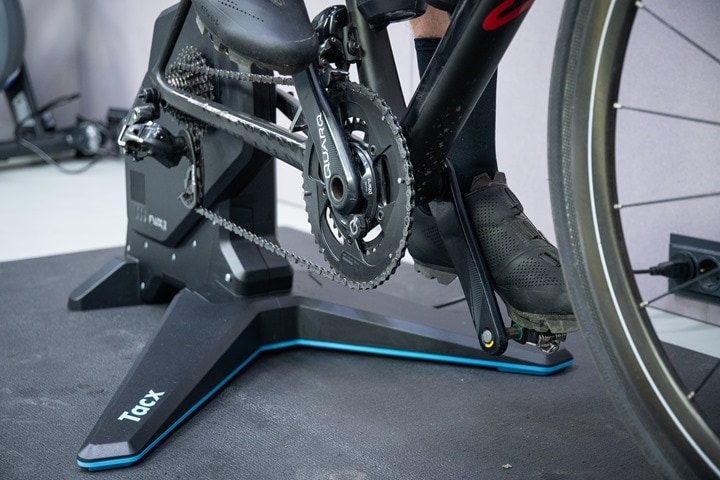
First up is installing the leg. On the Flux series, the leg is secured by two bolts, that affix it to the rest of the trainer. Unlike some trainers, the leg/trainer on the Flux isn’t foldable to save space during storage. However, it is beastly and fairly stable. This process will take you about 1-2 minutes:
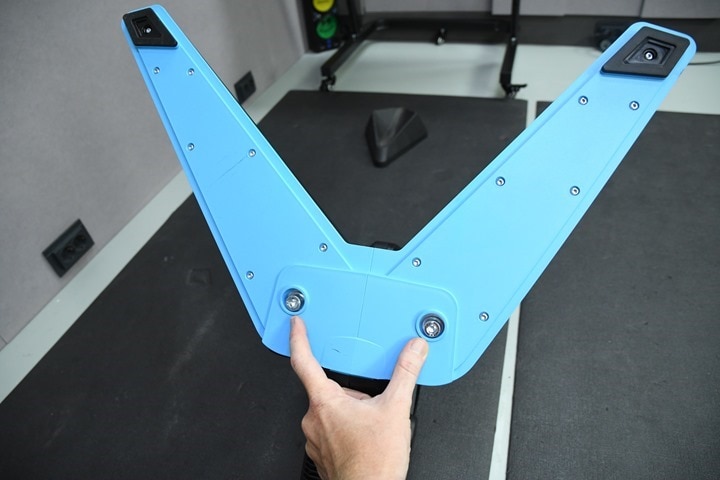
For a size comparison, I took this photo at the start of this entire review process more than 2 years ago. It’s comparing against a NEO 2 (left), Flux S (center), and Flux 2 (right). Note that the NEO 1/2/2T are all identical in footprint/vertical size. Just like the Tacx Flux 1/S/2/2.1 are.
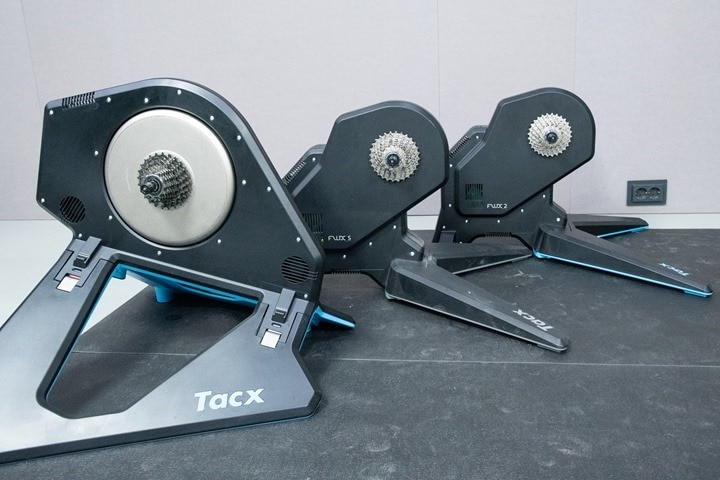
Like all trainers from Tacx, the Flux 2 doesn’t include a cassette. As such, you’ll need to pick one up. I typically buy Shimano Ultegra cassettes for my trainers (mostly for sound-testing consistency across videos), but I’ve also done a few SRAM ones and whatever else happens to be on sale from the bike shop. It generally doesn’t matter, except sometimes you’ll find some of the lower end cassettes (like a Shimano 105) don’t quite sound as quiet as mid to higher-end ones. If you’ve got a SRAM AXS bike, you’ll also need to get a different freehub adapter from Tacx as well. But since you just spent a boatload of money on that bike, spending more money will feel natural to you.
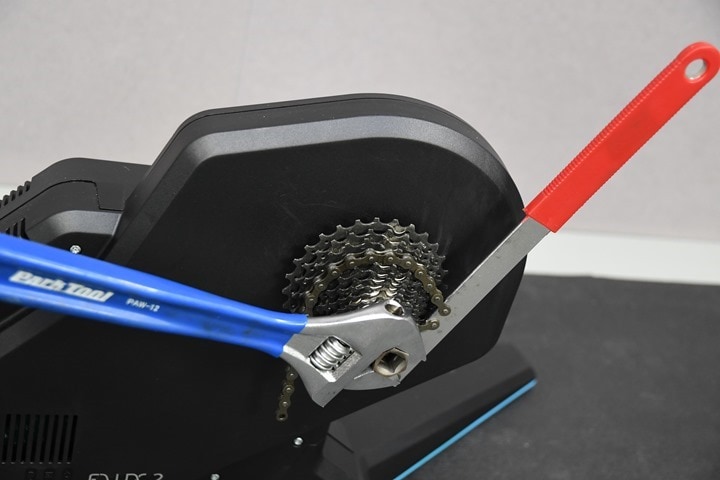
With that cassette, you’ll need two tools. A lockring tool (or lockring + a wrench, in my case), and a chain whip. In this case, you need the chain whip since you can’t get a good grasp on the flywheel.
Once you’ve got the cassette on, simply put in place either the quick release skewer or thru-axle adapter (depending on your particular bike). The unit includes a thru-axle adapter set for 142x12mm & 148x12mm. Here’s the exact set of adapters that comes with the Flux 2.1:
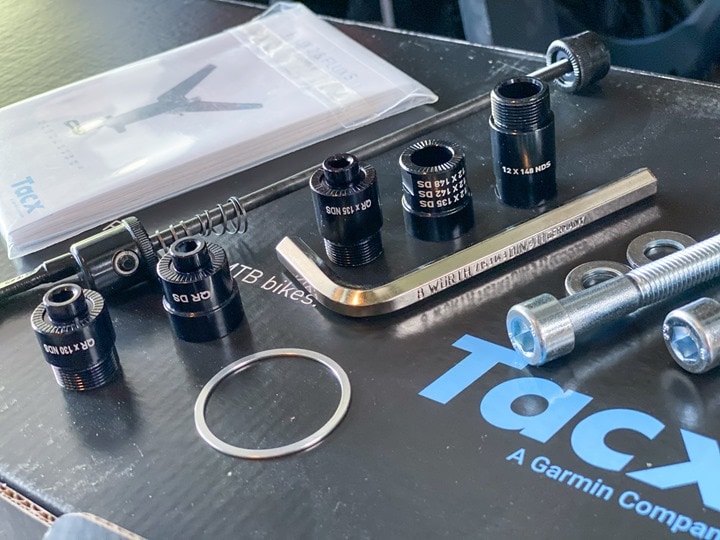
And more easily simplified here. DS = Drive Side (right side), NDS Non-drive side (left side). You’ll simply put one of each into side of the Flux 2.
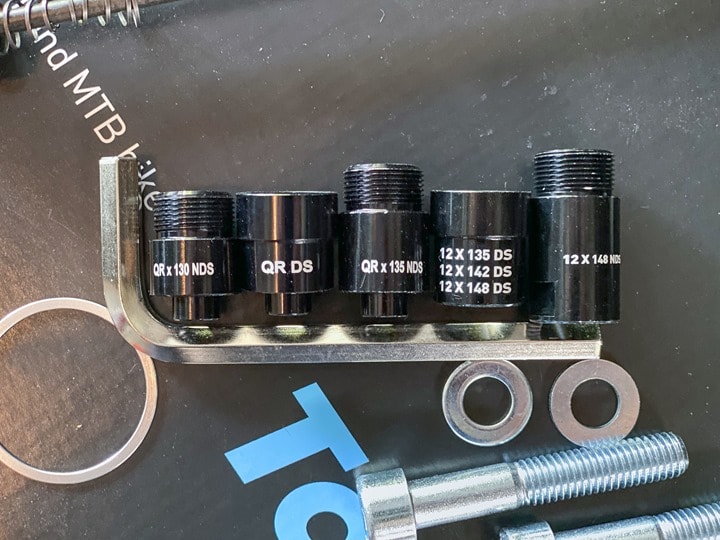
Once that’s done you’ll want to go ahead and plug it in. One nice thing about the Flux series is that the power brick is built into the bike. Meaning you only need a single non-brick-like cable running from the trainer to the wall (and a standard cable at that). I can’t think of any other trainers that offer that (even the Tacx NEO series has a separate power brick).
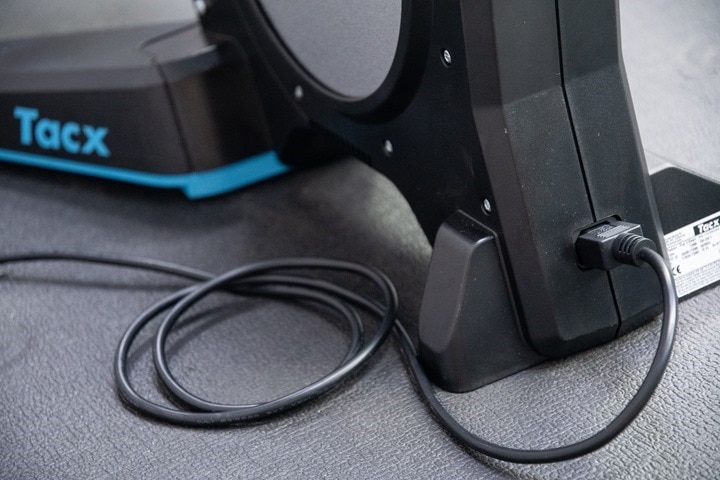
Note that the Tacx Flux series does require power for resistance. So you can’t use it sans-power and get any resistance.
Once plugged in, on the side of the unit you’ll see three LED status lights illuminated. These are for general power, then one for ANT+ & Bluetooth Smart connectivity.
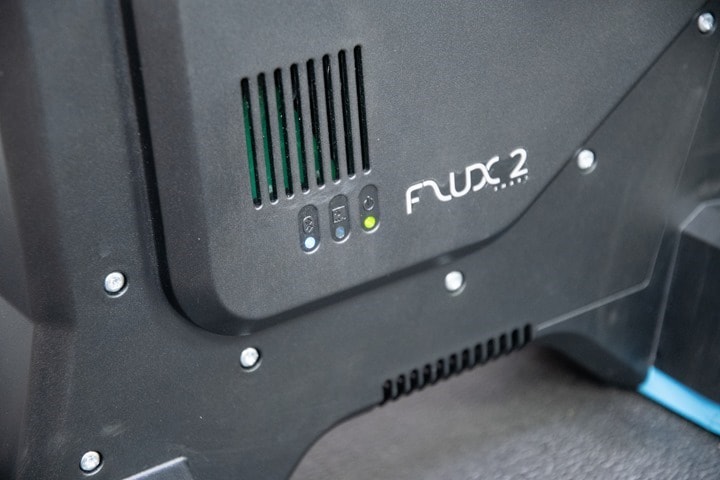
Once that’d done, go ahead and grab your bike, remove the rear wheel, and affix it to the trainer. While the Flux 2 doesn’t include (or require) a wheel block, I personally prefer to use one. I like that it makes my front wheel stay put. So I grabbed one out of the bin.
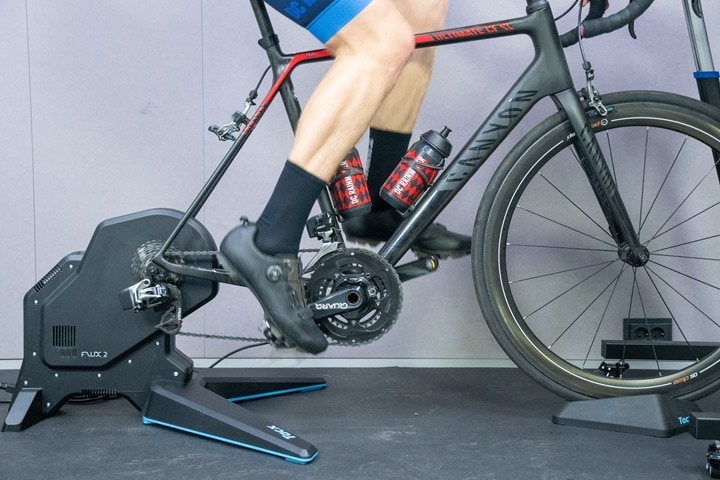
With everything set, we’ll talk about some of the basics of usage. App compatibility will be the next section, so this is more about things that aren’t specific to any one app. First, road feel.
Like I always say – for me personally, it’s hard to separate the fact that I’m riding indoors from outdoors. It’s still a trainer, and I’m still looking at a wall in front of me. My brain can only turn off so much of that. Still, much of the road-like feel is driven by the flywheel, and be it physical or virtual, flywheel sizes tend to be measured in weight. This impacts inertia and how it feels – primarily when you accelerate or otherwise change acceleration (such as briefly coasting).
The Flux 2 road-feel is…ok? It’s not great. But it’s not bad. It’s OK. Some 3-4 years ago it was pretty good for the price point, but with the KICKR CORE at the same basic price, the road feel there is far better (because ultimately, the KICKR CORE is simply a full KICKR from the year prior). You can see the flywheel below, it’s the big round silver disc and rotates while pedaling.
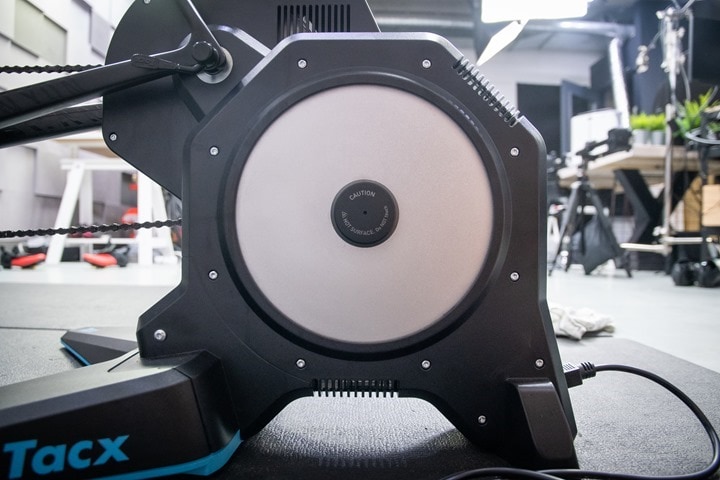
So what does it mean to be ‘OK’? Well, you’ll feel some of the momentum of an acceleration carry through, but not vastly so. It tends to feel like it tapers out a bit too soon compared to some of the higher end trainers. Typically momentum is driven by the flywheel weight. So a heavier flywheel weight responds with better momentum. If we look at the Flux 2, it’s got a flywheel weight of 7.6KG (but can simulate 32KG). Compare that to the KICKR Core at 5.44KG. The Elite Direto X sits at 4.2KG/9.2LBS, and I’d say is in the same basic road feel feel ballpark of the Flux 2.
To which you’re now asking – but wait, I thought it was all about weight? As the saying goes: It’s not the size, but how you use it. And ultimately, Wahoo uses their slightly smaller flywheel weight better, such that it feels better. Look, I don’t make the rules, but this one is easy.
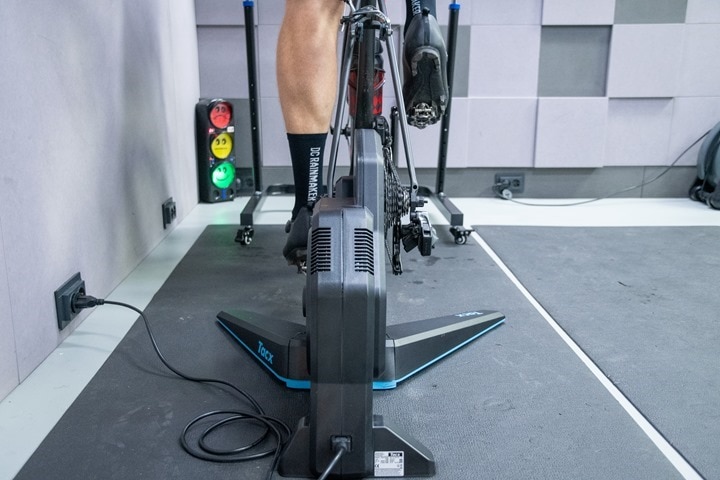
With the Flux 2 being a smart trainer, it’ll change resistance automatically in a few different ways, primarily driven by different applications/methods. But most of this all boils down to two core methods:
ERG Mode: Setting a specific power level – I.e., 200w. In this mode, no matter what gearing you use, the trainer will simply stay at 200w (or whatever you set it to).
Simulation Mode: Simulating a specific outdoor grade – I.e., 8% incline. In this mode, it’s just like outdoors in that you can change your gearing to make it easier or harder. Wattage is not hard-set, only incline levels.
In the case of simulation (aka slope) mode, the Tacx Flux 2.1 can simulate from 0% to 16% incline – which is about as high as you’d need for almost anything in Zwift, especially if you use the default Zwift “Trainer Difficulty” setting at 50%, which halves the incline. I personally prefer to keep it on 100%, since frankly, there’s no point in spending more money for a higher end trainer (or time on a climb) if you’re not going to simulate what the climb actually feels like.
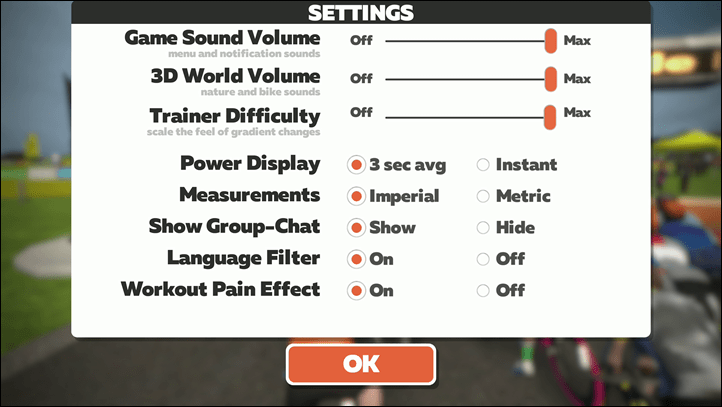
(Some people racing prefer to keep the trainer difficulty at a lower value, because it makes it easier to keep the cadence much higher. It technically doesn’t impact how fast you go on Zwift, but in reality it does make it easier for most people on climbs to have a lower difficulty level. Plus, if it didn’t make it easier (and thus often faster), then racers wouldn’t set it lower. Duh. But…you do you.)
For comparison, the Direto X can simulate 18%, and the Wahoo KICKR CORE can simulate 16%. In other words, all of these trainers will more than enough cover your pain and suffering.

The second mode the trainer has is ERG mode. In that case, the company claims up to 2,000w of resistance at 40KPH. Although, realistically, you don’t care about that. I can only barely (maybe) break 1,000w for a second or two, and even most front of the non-pro pack cyclists aren’t going to top 1,800w. The pros would only be just a bit beyond that. Said differently: Peak numbers don’t matter. Stability matters.
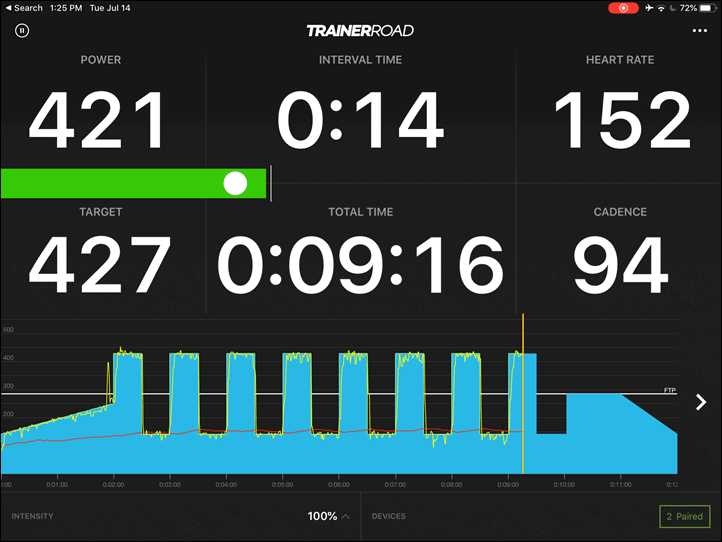
Now, I dive into all the nuances of this later on in the accuracy section, specifically including my 30×30 test via TrainerRoad, though it doesn’t really matter what method you use as long as you’re looking at big shifts in wattage.
App Compatibility:
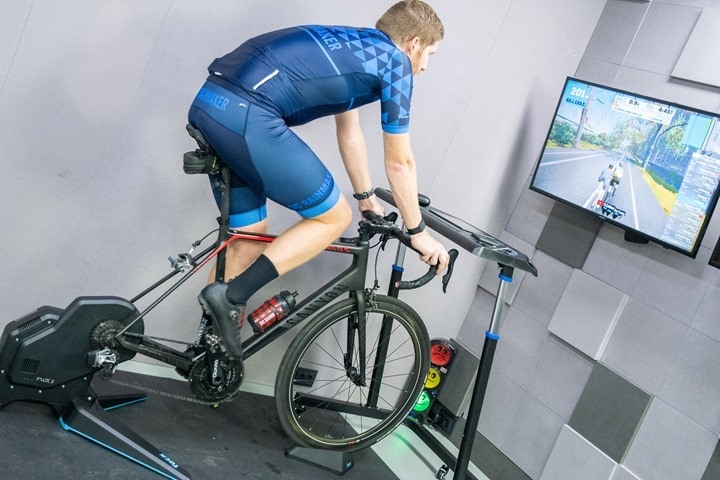
The Tacx Flux 2.1 follows the same app compatibility standards as previous Tacx products that are non-NEO series, and essentially follows the industry norms as you’d expect from a high-end trainer. As you probably know, apps like Zwift, TrainerRoad, SufferFest, Rouvy, Kinomap and many more all support most of these industry standards, making it easy to use whatever app you’d like. If trainers or apps don’t support these standards, then it makes it far more difficult for you as the end user.
Thankfully, that’s not the case here. The Flux 2.1 transmits data on both ANT+ & Bluetooth Smart, as well as allowing interactive resistance control across both ANT+ & Bluetooth Smart. By applying resistance control apps can simulate climbs as well as set specific wattage targets.
The unit supports the following protocols and transmission standards:
ANT+ FE-C Control: This is for controlling the trainer via ANT+ from apps and head units (with cadence/power data). Read tons about it here.
ANT+ Power Meter Profile: This broadcasts as a standard ANT+ power meter, with cadence data
ANT+ Speed/Cadence Profile: This broadcasts your speed and cadence as a standard ANT+ Speed/Cadence combo sensor
Bluetooth Smart Power Meter Profile: This broadcasts as a standard BLE power meter, with cadence data
Bluetooth Smart Speed/Cadence Profile: This broadcasts your speed and cadence as a standard BLE combo Speed/Cadence sensor
Between all these standards you can basically connect to anything and everything you’d ever want to. Be it a bike computer or watch, or an app – it’ll be supported.
In the above, you’ll note there’s cadence data baked into the various streams. That’s handy if you’re connecting to Zwift on an Apple TV, due to Apple TV’s two concurrent Bluetooth Smart sensor limitation (plus the Apple TV remote). This means you can pair the trainer and get power/cadence/control, while also pairing up a heart rate strap.
For me, in my testing, I used Zwift and TrainerRoad as my two main apps (which are the two main apps I use personally). In the case of Zwift, I used it in regular riding mode (non-workout mode, aka SIM mode), whereas in the case of TrainerRoad I used it in a structured workout mode (ERG mode). I dig into the nuances of these both within the power accuracy section.
Starting with Zwift, you can see the Tacx Flux 2 listed as not just a controllable trainer, but also within the regular power meter and cadence section. You’ll want to pair it up as a controllable trainer (which will also pair it as a power meter):
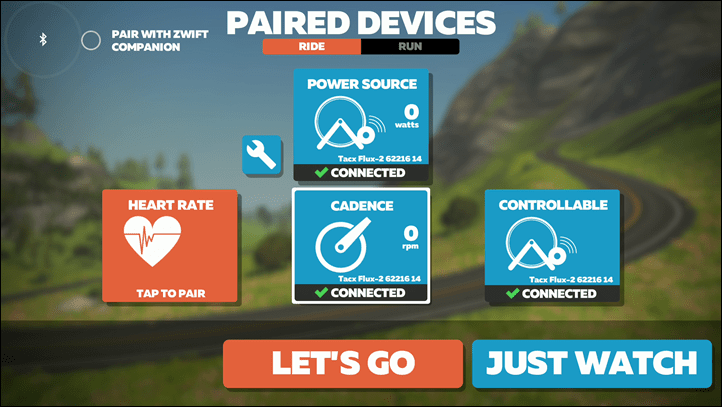
You’ll see the trainer enumerated in a fairly similar manner on TrainerRoad as well:
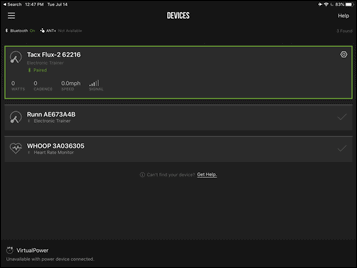
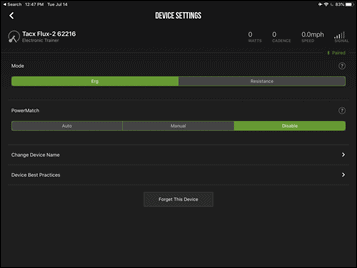
Also, TrainerRoad’s tips page on using smart trainers in ERG mode:
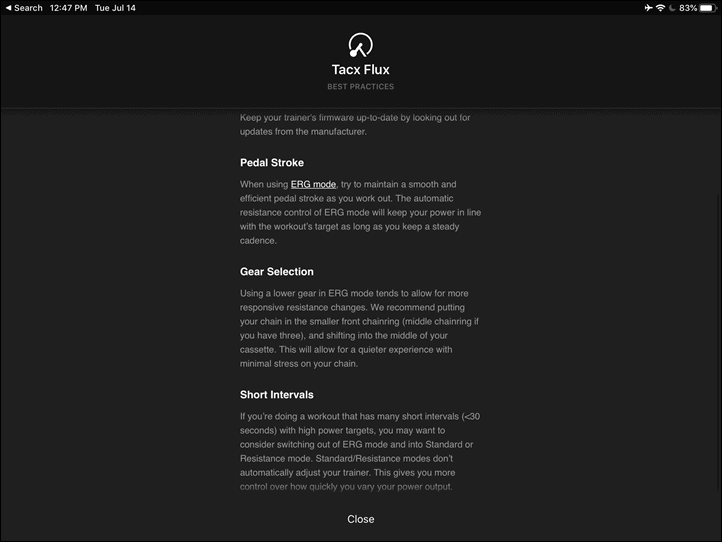
And one of a number of workouts I did with the Flux 2.1:
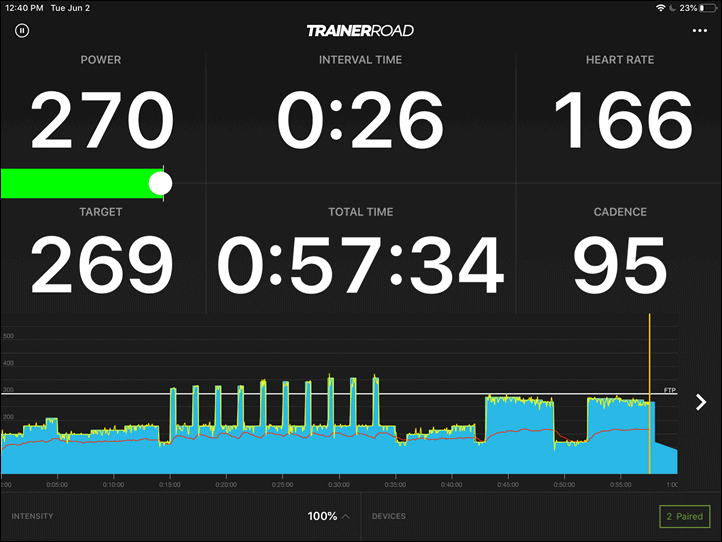
When it comes to calibration, you can do so within certain 3rd party apps, or from the Tacx utility app (more on that in a second). While some trainers tend to be more susceptible to not calibrating, I haven’t seen that be the issue with the Flux 2.1. It seems pretty chill about it, and seems to handle longer periods of time without calibration with no issue.
Still, for the Flux 2.1 specifically I’d recommend doing a calibration anytime the temperature changes significantly (meaning, if you leave it in a garage and one morning it’s really cold, and the next time you train it’s hot and steamy). Or, if you move it some long distance, it’s always a good practice.
As far as calibration goes, some apps support it in certain situations, however, not all. For example, TrainerRoad over Bluetooth Smart on an iPad doesn’t support it. And neither does Zwift on Apple TV over Bluetooth Smart. Whereas sometimes over ANT+ FE-C it’ll work/trigger. I did my calibrations using the Tacx app instead.
Speaking of that app, Tacx does have their own app which is used for updating the firmware and doing one-off calibrations. You can also connect to the trainer and perform basic test with it. Upon connecting, you’ll see options at the left from the menu, including the ability to check/update firmware:
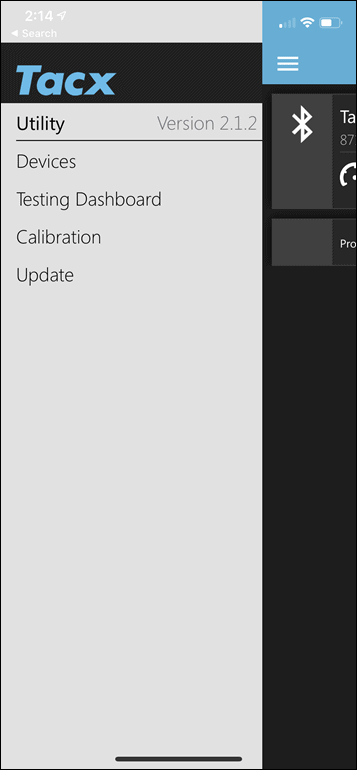
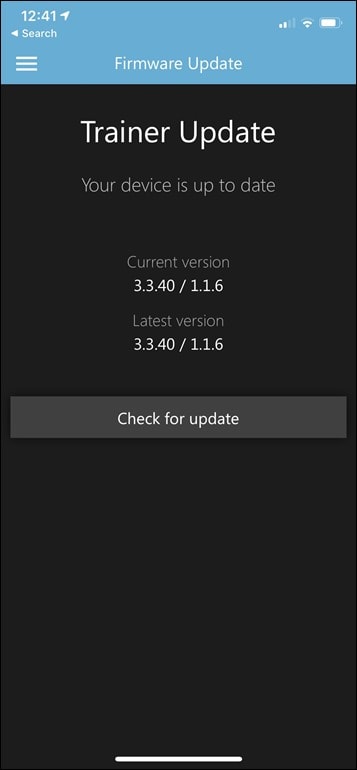
You can also go into a testing dashboard you’ll never use, as well as the ability to update the rider weight. This adds a component of flywheel realism above/beyond the baseline flywheel (called Simulated Flywheel by Tacx). Note that if using ANT+, Zwift will provide that information automatically to the trainer, but not via Bluetooth Smart. Also, you can toggle on/off the broadcasting of the ANT+ Speed/cadence profile.


And finally, you can do a spindown calibration. Quick and easy, and with that, we’ve seen all there is to see in the Tacx Utility app and beyond.
Power Accuracy Analysis:
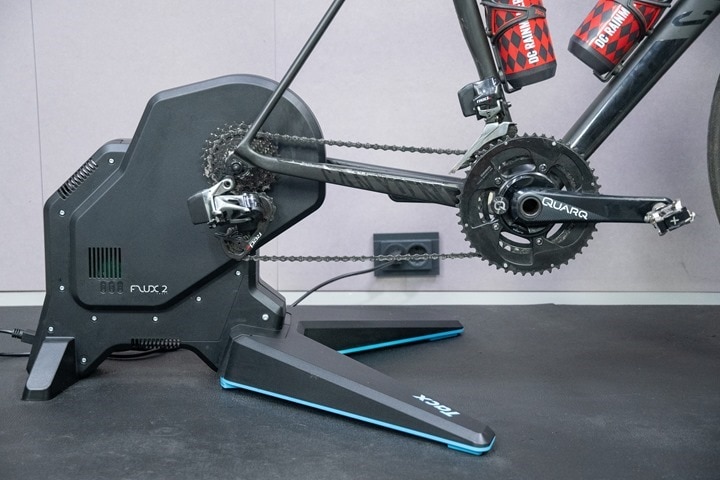
As usual, I put the trainer up against a number of power meters to see how well it handled everything from resistance control accuracy, to speed of change, to any other weird quirks along the way. I outline how I do power meter & trainer accuracy testing here, in case you want to make your own comparisons.
In my case I used one primary bike setup as follows in two configurations:
Canyon Bike Setup #1: Favero Assioma Duo power pedals (dual-sided), Quarq DZero
Canyon Bike Setup #2: SRM X power pedals (dual-sided), Quarq DZero
Canyon Bike Setup #3: A different set of Favero Assioma Duo power pedals (dual-sided), Quarq DZero
This is all in addition to the trainer itself. Note that because you remove the rear wheel I can’t use something like a PowerTap hub to compare as well (which I would use in power meter testing normally).
In my case, I was looking to see how it reacted in two core apps: Zwift and TrainerRoad (Bluetooth Smart on Apple TV and iPad). The actual apps don’t typically much matter, but rather the use cases are different. In Zwift you get variability by having the road incline change and by being able to instantly sprint. This reaction time and accuracy are both tested here. Whereas in TrainerRoad I’m looking at its ability to hold a specific wattage very precisely, and to then change wattages instantly in a repeatable way. There’s no better test of that than 30×30 repeats (30-seconds at a high resistance, followed by 30-seconds at an easy resistance).
There’s two ways to look at this. First is how quickly it responds to the commands of the application. So for that, we need to actually look at the overlay from TrainerRoad showing when it sent the command followed by when the Flux 2.1 achieved that level. Here’s the levels being sent (the blue blocks)) by TrainerRoad (in this case via Bluetooth Smart on iPad) and how quickly the Flux 2.1 responded to it:

We’ll come back to that random spike prior to the first interval. But, in general it took about 4-6 seconds for it to stabilize from ~140w to ~428w, sometimes 4 seconds, sometimes a second or two longer. That’s a bit slower than I like to see. I find the sweet-spot around 1-3 seconds. Any faster and it feels unnatural, and any slower and you start to bleed into the purpose of shorter intervals.
In terms of stability of the power within an interval, that was tied to speed. On the first 3 intervals above I was in the smaller front chainring as recommended by TrainerRoad, and was in one of the two highest gears on the cassette (closest to the wheel). However, for intervals 4-6, I went towards the middle of the cassette, and you can see it wobbles a bit more in accuracy. Whereas the last two intervals I went back towards the top of the cassette and it cleaned up nicely. It had no effect though on how quickly it could get to that point.

Now, if you’re going from 150w to 250w or 300w, then honestly, it’ll be within 1-3 seconds. The more the wattage jump, the slower it’ll be. So while it seems slightly more sensitive to speed in ERG mode than other trainers, as long as you use the right gearing it’s perfectly fine in terms of stability (more on accuracy later).
As for the outright accuracy of that set, it’s about 10w lower than the Quarq and about 2-4w lower than the Favero Assioma pedals, at ~430w. That’s smack in the ballpark of overlapping accuracy ranges, especially when you consider drivetrain losses. I’d probably like to have seen the Quarq actually a couple watts lower.

However, before we move on – do note that random spike just before the first set. This is a ‘resistance surge’, and one of the three issues I’ve seen with this specific unit. In this case, the trainer did an uncommand surge in resistance to roughly 350w+. This is hardly the first time this has happened. The surge lasts a few seconds and then returns to whatever it was doing prior.
So, let’s look at a few more things sets (and surges).
In this next set from this past weekend’s Zwift L’Etape du Tour, you see that the Quarq DZero, Favero Assioma, and Tacx Flux were generally pretty darn close. The Quarq and Favero were higher than the Flux 2, but mostly inline with expected drive-train losses. Sometimes the Quarq was a hair higher than I’d like, but in the right ballpark. Here’s that data set:

However, what you also see are points where the purple line of the Flux 2 random spikes well above the rest. In fact, if I remove the smoothing I applied to the graph above, you’ll see it spikes to 2,000w:

And, when I remove that smoothing you see even more funky things. You’ll notice all the times the purple line touches the bottom axis of the graph. This is when the Flux 2 connectivity briefly drops out the power.
But wait, there’s more, each time it drops the power, it first punches me in the #$ #@ by spiking my wattage to 500w. In some cases the resistance surges are real (and I feel them), and in some cases they’re phantom (and I don’t feel them in resistance change but it reports a spike to the app).

Still, if we set those moderately significant annoyances aside, and look purely at power accuracy, the units all follow each other pretty darn closely. Again, you’re looking at different measurement points on the bike, all with differing accuracy claims. But all of these are all playing bumble-bee soccer fairly well, on a course that includes flats, climbs, descents…the whole bit.

So, let’s look at another. This time my dumb idea to ride the Mont. Ventoux course on Zwift earlier this week. I don’t know why I thought spending nearly 2 hours riding a trainer on a Monday afternoon would be a good idea, but I did it…for science. Here’s that data set:

Now, in general the Favero Assioma Duo pedals were slightly lower than I’d have preferred, so that’s a little bit quirky, but not substantially so. Or, perhaps the others were high. Welcome to my life.
Still, a mere one minute into it I get punched by the power surges. Then again two minutes later:

After that, it thankfully settled down in terms of surges.
However, about an hour later as I climbed my way up Ventoux I started getting dropouts of resistance. Note – that’s different than a connectivity dropout. In this case, the resistance AND connectivity disappeared. So basically I was instantly pedaling against air:

Now, this is a good point to basically say: I know this wasn’t a transient connection issue.
(Read: I know what I’m doing here)
How?
Well, let me count the ways:
These incidents occurred:
A) In two different locales (home and office)
B) Across four different OS platform types
Specifically seen across:
1) iPad TrainerRoad
2) Windows Zwift
3) Apple TV Zwift
4) Garmin FR935 connected watch
Oh, and in two different application modes:
1) ERG Mode
2) SIM Mode
On two different protocols:
1) ANT+ for Windows and the watch
2) Bluetooth Smart for the iOS/Apple TV
Oh, and did I mention everything was dual-recorded on each session too?
In other words, I’m really darn sure this isn’t a ‘your WiFi is interfering’ issue. Plus, WiFi interfering doesn’t cause the entire trainer to set the wattage to 0w or 500w or 2,000w.
Now, all that annoyance said, there’s two notable things:
A) Power accuracy (the point of this section) seems to be largely fine
B) I actually haven’t seen others with this same precise issue
Now, others may have other issues. But I’ve done a pretty good look at the Tacx Flux Owners Facebook group and I don’t see replications of my specific issues, which leads me to believe it’s plausible it’s a one-off unit. Though, that unit worked fine for the first month or so.
Atop that, while Tacx has seen some of these issues (notably the 2,000w spike), they thought they had that one resolved. So, as of this morning they’re back to digging into things. They agree though that this likely isn’t a connectivity issue by WiFi or such. So, I’ll circle up down the road.
Now remember, my my entire point in going down the Tacx Flux 2 rabbit hole was to see if I could remove my ‘DO NOT BUY’ statement from the top of my previous Flux 2 post. So, while what I saw here in this section certainly isn’t good, it’s technically an upgrade from what I had written before. I guess. Kinda. Maybe?
(Note: All of the charts in these accuracy portions were created using the DCR Analyzer tool. It allows you to compare power meters/trainers, heart rate, cadence, speed/pace, GPS tracks and plenty more. You can use it as well for your own gadget comparisons, more details here.)
Trainer Comparisons:
I’ve added the Flux 2 into the product comparison database. This allows you to compare it against other trainers I’ve reviewed. For the purposes of this particular table, I’ve compared it against the Elite Direto X, Wahoo KICKR CORE, and Saris H3. While the H3 is slightly higher in price, it’s also so often on sale for $ 800-$ 850USD, that one should at least check the price before making a purchase decision. You can also mix and match and create your own trainer comparison charts with just about any trainer on the market in the aforementioned/linked product database.
| Function/Feature | Tacx Flux 2 | Elite Direto X | Saris H3 (CycleOps Hammer 3) | Wahoo Fitness KICKR CORE |
|---|---|---|---|---|
| Copyright DC Rainmaker – Updated July 15th, 2020 @ 5:21 pmNew Window Expand table for more results | ||||
| Price for trainer | $ 899USD/€799 | $ 899 | $ 999 | $ 899 |
| Trainer Type | Direct Drive (no wheel) | Direct Drive (No Wheel) | Direct Drive (no wheel) | Direct Drive (No Wheel) |
| Available today (for sale) | YEs | Yes | Yes | Yes |
| Power cord required | Yes | Yes (no control w/o) | Yes | Yes |
| Flywheel weight | 7.6kg (simulated 32.1kg) | 4.2KG/9.2LBS | 20lb/9kg | 12.0lbs/5.44kgs |
| Maximum wattage capability | 2,000w @ 40KPH | 2,100w @ 40KPH / 3,250w @ 60KPH | 2,000w | 1800w |
| Maximum simulated hill incline | 16% | 18% | 20% | 16% |
| Measures/Estimates Left/Right Power | No | 9EUR one-time fee | No | No |
| Can rise/lower bike or portion thereof | No | No | No | With KICKR CLIMB accessory |
| Can directionally steer trainer (left/right) | No | With steering accessory & compatible app | No | No |
Don’t forget you can mix and match your own trainer product comparison tables using the database here.
Summary:
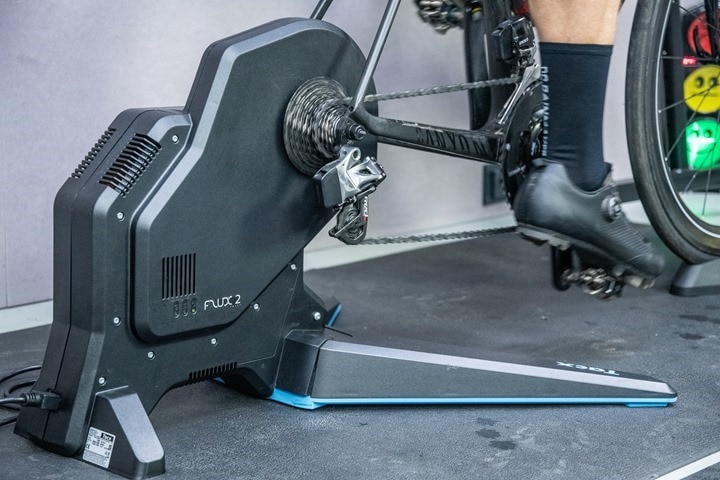
After two years since announcement, and some 18+ months of being on the market and people buying trainers – the big question is: Did Tacx fix what initially blocked me from recommending it? Yes. Tacx did fix the accuracy issues. Without question, those are within range of the specs. Some days here’s a tiny bit more disagreement than other days, but within the state specs of the combined units it’s relatively close on ERG and SIM mode. So, for the thing I set out to validate – that part is fine.
Unfortunately, instead I found other issues around power surges and connectivity drops. Tacx says they haven’t seen the issues that I saw, and a browsing of the Tacx Flux Facebook owners group doesn’t show these issues either. So hopefully it’s just a one-off. Tacx is trying to track down the issues.
And if those issues were just a one bad unit one off, then yeah – I’d be mostly happy with this unit from a technical standpoint. Maybe not for the price, but at the right price I would be. And I think that may be part of the overall issue. With the current $ 899USD pricing, the road feel and audible noise of the KICKR CORE is just a better option for the same price (plus multi-channel Bluetooth connections). Of course, the KICKR CORE hasn’t been issue free either. So, I’d say those two ‘pick your issues’ buckets cancel themselves out. There’s the Elite Direto X slightly cheaper, but good luck finding that in stock.
So, I guess 18 months on my answer has shifted from ‘No’ to ‘Maybe?’. I don’t know. If we assume that my issues are a one-off unit (given I don’t see much confirmation of these specific issues elsewhere), then the answer would be ‘If ya get a good deal on it, then sure’. In that situation, I don’t think anyone would be unhappy with the choice. Which isn’t to say I don’t like other Tacx trainer offerings. I use the Tacx NEO 2 as my main trainer at home when not testing stuff, and I recently reviewed the budget Tacx Flow, which is incredibly fantastic value for the money. But at present, I feel like the Flux 2 sits in no-mans land right now from a pricing to feature value standpoint.
With that, thanks for reading!
Found this review useful? Or just want a good deal? Here’s how:



Hopefully you found this review useful. At the end of the day, I’m an athlete just like you looking for the most detail possible on a new purchase – so my review is written from the standpoint of how I used the device. The reviews generally take a lot of hours to put together, so it’s a fair bit of work (and labor of love). As you probably noticed by looking below, I also take time to answer all the questions posted in the comments – and there’s quite a bit of detail in there as well.
I’ve partnered with Clever Training to offer all DC Rainmaker readers exclusive benefits on all products purchased. By joining the Clever Training VIP Program, you will earn 10% points on this item and 10% off (instantly) on thousands of other fitness products and accessories. Points can be used on your very next purchase at Clever Training for anything site-wide. You can read more about the details here. By joining, you not only support the site (and all the work I do here) – but you also get to enjoy the significant partnership benefits that are just for DC Rainmaker readers. And, since this item is more than $ 99, you get free 3-day (or less) US shipping as well.
Tacx Flux 2.1 – (Clever Training)
For European/Australian/New Zealand readers, you can also pickup the unit via Wiggle at the links below, which helps support the site too! With Wiggle new customers get 10GBP (or equivalent in other currencies) off their first order for anything over 50GBP by using code [Currently Disabled] at check-out after clicking the links below.
Tacx Flux 2.1 (EU/UK/AU/NZ – Wiggle)
And finally, below I made a handy list of accessories that most folks getting a trainer for the first time might not have already.
Thanks for reading! And as always, feel free to post comments or questions in the comments section below, I’ll be happy to try and answer them as quickly as possible.
| Product | Amazon Link | Note | |
|---|---|---|---|
 |
Basic Trainer Mat | Amazon | This is a super basic trainer mat, which is exactly what you’ll see me use. All it does is stop sweat for getting places it shouldn’t (it also helps with vibrations too). |
 |
Cassette Installation/Removal Tools | Amazon | There are *many* variations of cassette removal tools, this is the best bang for your buck. Don’t overthink this. You’ll likely only use this tool once every 2-3 years. |
 |
Front Wheel Riser Block | Amazon | Here’s the thing, some people like front wheel blocks, some don’t. I’m one of the ones that do. I like my front wheel to stay put and not aimlessly wiggle around. For $ 8, this solves that problem. Note some trainers do come with them. Also note, I use a riser block with *every* trainer. |
 |
Shimano R7000 105 Cassette (11-speed) | Amazon | This is a Shimano 105 cassette (thus, slightly more budget compared to the Ultegra), in most cases, you probably won’t notice the difference. Ensure that the number of speeds matches your bike (e.g. 11-speed, 10-speed, 9-speed, etc…). |
 |
Shimano R8000 Ultegra Cassette (11-speed) | Amazon | This is a Ultegra cassette, you can save about $ 10-$ 15 by picking up a Shimano 105 instead. Ensure that the number of speeds matches your bike (e.g. 11-speed, 10-speed, 9-speed, etc…). |
 |
Tacx Tablet Bike Mount | Amazon | I’ve had this for years, and use it in places where I don’t have a big screen or desk, but just an iPad or tablet on my road bike bars. |

